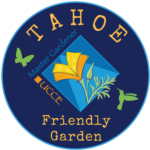Tahoe Friendly Garden: Beneficial Wildlife Habitat Resources

Living in Harmony… A Tahoe Friendly Garden considers the pros and cons of which critters you want to invite in your yard. Berries, seeds, and leaves are an important food source for birds, mammals and beneficial insects and plants provide nesting materials and shelter from predators and the elements.

- Coneflower, Rudbekia californica (attracts bees and other pollinators)
- California fuschia, Epilobium cancum spp. Canum (attracts hummingbirds)
- Creeping mahonia, Mahonia repens (attracts pollinators and birds)
- Scarlet Bee Balm, Monarda didyma
- Blanket flower, Gaillardia pulchella
Your garden is part of the ecosystem. Trees, shrubs and other plants provide both food and shelter for wildlife.
- Plant a variety of species
- Select plants that flower and bear fruit at different times of the year.
- Flowers and fruits of some plants attract hummingbirds and butterflies to your yard.
- Providing bee habitat can be beneficial to your fruit & vegetable harvests.
- Clean, freshwater is as important to wildlife as it is for people
An inviting habitat: With habitat disappearing at an alarming rate, you can help provide wildlife with an oasis of the habitat they need to thrive. The native plants that you use can meet the needs, including food and cover, of native wildlife without causing long-term damage to local plant communities.
Benefits of Landscaping with Native Plants:
- Save Water: once established, many native plants need minimal irrigation beyond normal rainfall.
- Low maintenance: low maintenance landscaping methods are a natural fit with native plants that are already adapted to the local environment. Little to no fertilizer, little to no pesticides, less pruning and less of your time
- Pesticide Freedom: native plants have developed their own defenses against many pests and diseases. Reducing or eliminating pesticide use allows natural pest control to take over and while keeping garden toxins out of our creeks and watershed.
- Wildlife viewing: native plants, birds, butterflies, beneficial insects, and interesting critters are “made for each other.” Research shows that native wildlife prefers native plants
- Support local ecology: as development replaces natural habitats, planting gardens, parks, and roadsides with California natives can provide a “bridge” to nearby remaining wildlands.
Beneficial Wildlife Habitat Resources
- US Forest Service Celebrating Wildflowers https://www.fs.fed.us/wildflowers/pollinators/index.shtml
- UC Integrated Pest Management http://ipm.ucanr.edu/
- Lady Bird Johnson Wildflower Center http://www.wildflower.org/plants-main
- Pollinator Partnership http://www.pollinator.org/
- CNPS Gardening with Native Plants http://www.cnps.org/cnps/grownative/why_native.php
- the Xerces Society for Invertebrate Conservation;
- Pollinator Conservation Program http://www.xerces.org/fact-sheets/
- Four Principles to Help Bees and Butterflies https://www.xerces.org/blog/earth-week/bring-back-the-pollinators
- Monarch Butterfly: North America’s Migrating Insect www.fs.fed.us/monarchbutterfly/
- Attracting Pollinators to Your Garden Using Native Plants https://www.fs.fed.us/wildflowers/pollinators/documents/AttractingPollinatorsV5.pdf
- UCCE Master Gardener of Lake Tahoe Resources
- Plants for Pollinators http://cecentralsierra.ucanr.edu/files/169046.pdf
- Bugs Are Incredible: Introducing the Good, the Bad and the Ugly http://cecentralsierra.ucanr.edu/files/239782.pdf
